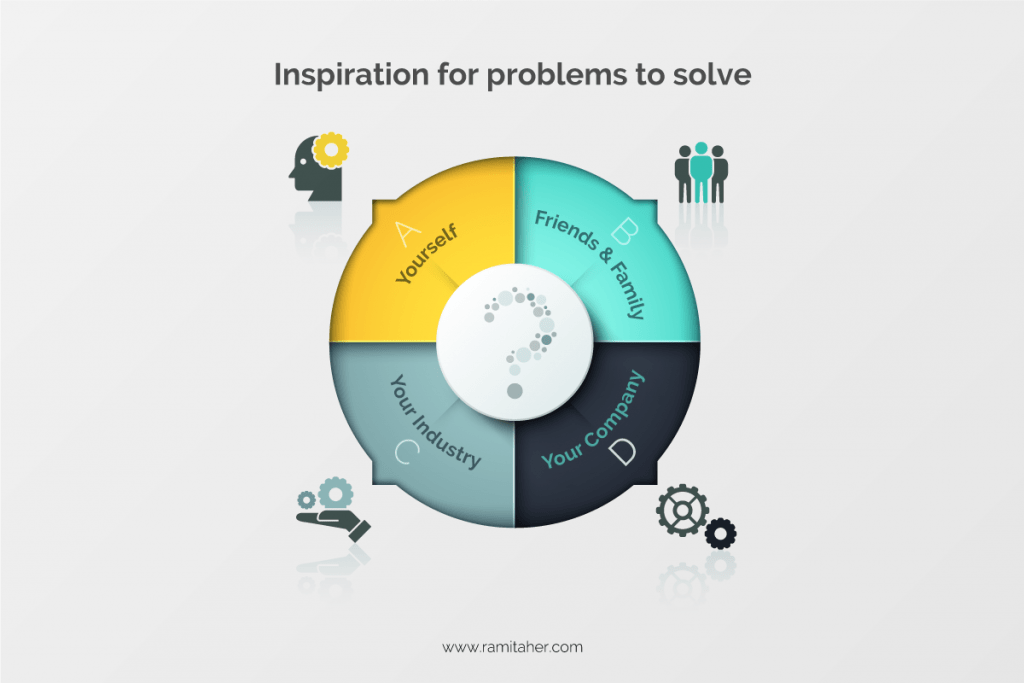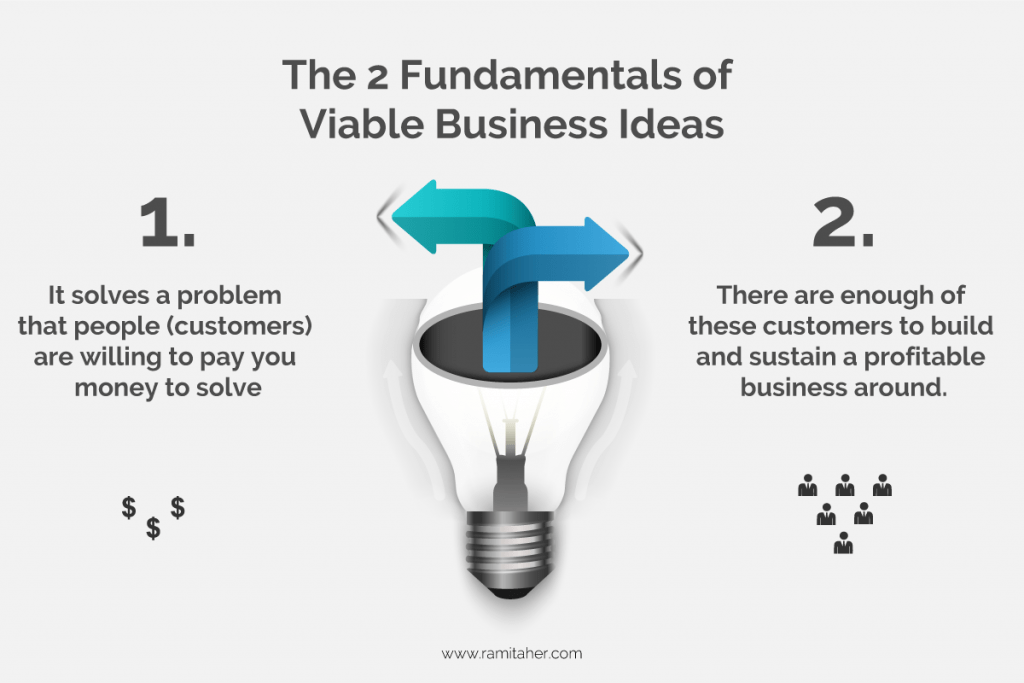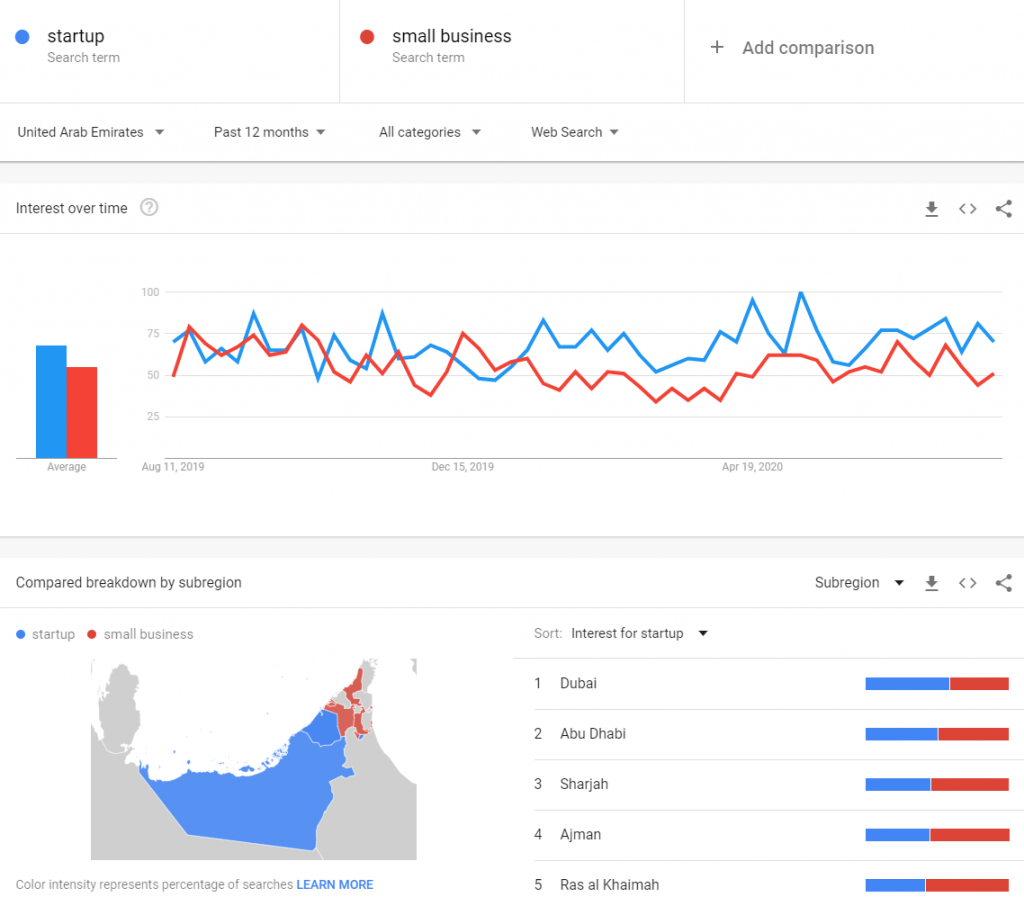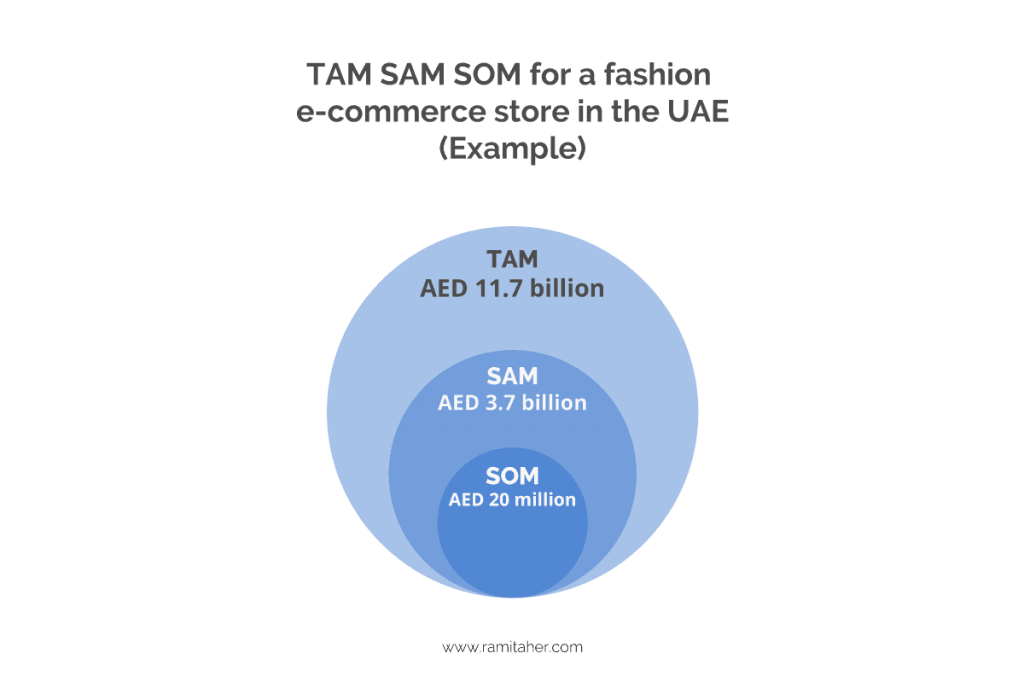Many people want to start their own business and think about it all the time. The part many entrepreneurs struggle with is, what business should I start? If you’re an aspiring entrepreneur, but you’re not sure what business idea to pursue. this article is for you.
I have good news for you, you don’t have to be a genius to come up with great business ideas, it’s a framework, you just have to learn the process.
Follow this step-by-step guide and you’ll get to generating awesome business ideas in no time. If you do come up with a great idea by following this guide, share it in the comments, it might inspire other entrepreneurs to start working on their ideas.
Step 1: Don’t Start with The Business Idea
This may sound counter-productive, but this is the most common mistake entrepreneurs make when launching a new business or thinking about new business ideas.
Filled with excitement, they dive right into building the solution without giving critical thought to what problem they are solving.
They invest time, money, and resources into building their product or service, and launch their new company, only to realize (often too late) that customers don’t care about their product/service.
They end up in what you call a “solution in search of a problem”.
Solution in search of a problem
- A proposal that does not solve any problem or provide any value or that is intended to solve a problem which does not really exist.
If you want to avoid that fate when launching your startup or small business, this article is for you.
Y Combinator, regarded as the top accelerator worldwide, has funded 2,000+ startups estimating an overall total of more than $100 billion, “build something people want” is one of the first pieces of advice they tell their founders.
Step 2: Start with Identifying Problems to Solve
A business idea that doesn’t solve any problem or fulfill a need is doomed to fail. Not all problems are created equal, but to generate a successful business idea, you need to solve a problem your customers have and are willing to pay you to solve it for them.

Where to look for problems?
Your personal life and experience
Most founders first look at their own problems as an inspiration for potential ideas.
Look at your personal experiences, have you had a negative buying experience recently? Perhaps you’re helping a friend prepare for her wedding, and your jaw DROPPED when you looked at the prices and markups of wedding dresses (or anything wedding related really). And you thought to yourself, I’m sure there’s a better alternative.
This is exactly what Egyptian Ghada Eltanawy did. She co-founded online dress rental service La Reina in 2017, in an effort to make expensive evening and wedding gowns more accessible to the everyday woman.
You solve the problems you have, then find out if others have the same problem. This is often how great ideas start. Get to solving.
Family and Friends
Within your family or network of friends, are the same conversations/problems popping up again and again without a solution?
If for example, members in your family or your friends have a problem finding a good dentist within a reasonable distance, maybe this is a hint to start an app that connects patients with good dentists within a certain radius with customer reviews and booking functionality. Of course, this example is fictitious, but this is how great ideas start.
Your Employer and Industry
This is another great source of inspiration; say you work in the HR department and your company is always struggling to find quality hires, the recruitment agencies in your industry or location don’t have access to the talent you’re looking for.
It could be that specialized talent is scarce in your area, or it could be because there are no recruitment agencies in your area that focus on your industry. It’s time to investigate and see if there is a business opportunity here.

Keep your eyes and ears open
Wherever you are, observe people around you and keep listening, what are they talking/complaining about? What areas are they struggling with? What topics/problems keep popping up again and again?
Keep notes and write these potential problems either in a notepad or on your phone, keep revisiting your notes, do you see a pattern or theme emerging?
Look for problems you can understand well
As a startup consultant, I get this question all the time, what business should I start? What are the top businesses to launch?
While it’s true that some industries are growing at higher rates than others, an idea is worth nothing without good execution.
You, the founder, and your team are as important to the success of your business as the idea, if not more. An “Ok” idea executed well, is far better than a “brilliant” idea executed poorly.
That’s why you need to look for problems you can understand well, problems you feel passionate about, problems you have a personal connection with. The better you can relate to the problem and the people affected by that problem, the better solution you can provide to that problem.
Imagine you’re a chef, and you’re vegan. You’re constantly struggling to find good vegan restaurants in your town or area. Say there are also no good steakhouses in your area. What would be the more appropriate business idea for YOU? Opening a vegan restaurant, or a steakhouse? You do the math.
Maybe digital marketing is a growing industry, but if you know nothing about it and have zero skill or experience in that domain, the fact that it’s growing means nothing. Unless you take the time to learn the industry, understand it well enough to provide value to your customers, you won’t be able to excel in that field.
Step 3: Evaluate the Problem
Hopefully, by now, you have identified a few potential problems that warrant further investigation. It’s time to evaluate the scope of the problem.
For a business idea to be viable, it must meet two fundamental requirements:
- It solves a problem that people or businesses (customers) are willing to pay you money to solve (at a profit to you).
- There are enough of these customers to build and sustain a profitable business.

Are people willing to pay to solve the problem?
Whether people would pay to solve that problem has to do with the pain and gain, or cost and benefit associated with that problem.
We are surrounded by problems all around us, every day. Some are bigger than others, some don’t bother us (enough), and some we can’t solve (yet, things can always change), and we just learn to live with or around them.
Say you have a small headache, it might bother you a little, but not enough to go to a doctor or pharmacy. This is a small problem.
Now, say this headache is getting more intense, now it bothers you more, you go to a pharmacy to get headache medication. The problem grew and you paid to have it solved.
Now, say this medication didn’t help and the headaches are getting more frequent, now you go to a doctor and pay more to have the problem solved. In a nutshell, the bigger the problem, the more you are willing to pay to solve it.
You need to evaluate the problem you are solving and see whether (and how much) people are paying to solve that problem.
An easy way to figure that out is to look for existing businesses solving the same problem and see how much they are charging; do they have customers? Are they successful? Growing? Going out of business? This will give you an indicator of whether you can find customers at your price point.
Another, and perhaps, a better way to evaluate the problem is to talk directly to potential customers. Ask them if they tried anything to solve that problem, how much did they pay? Did it work? Have they tried multiple solutions? If none of the solutions worked, how much are they willing to pay for a working solution?
Are there enough people facing the problem?
Up until this point, you have done the following:
- You identified a problem you or some of the people you know are facing.
- You or a small section of your friends are willing to pay money to solve that problem.
Now the big question is, does this apply for the bigger population? Are there enough people facing the same problem? Is this a universal problem or a unique one?
Where Can I Find People Affected by the Problem?
Some problems are easier to figure out than others, good places to look include:
Online Groups and Communities
Look for online groups and communities that are related to your problem topic, places like Facebook, Reddit, or LinkedIn.
- Are they active? Are people posting daily/weekly? Or is it a ghost town?
- Do they have many members (thousands and more) or just a handful?
- Are many of these members located in your area? Is there a local chapter for your location?
- What topics are discussed the most? Does your problem come up often?
These are all good indicators on whether your business idea is viable or not, it will give you insights on how common your problem is, how people are affected by it, what they’re currently doing to solve that problem, and other businesses providing solutions to that problem.
It is also a good starting point for research, you can join these communities and ask them directly about their experience with the problem (without pitching your own solution), at this stage, you’re not trying to come up with a solution, you’re just trying to understand the problem better.
Social Media Sites
Social media sites like Instagram, Twitter, Facebook, Pinterest, or LinkedIn (if it’s a business problem) are good research candidates to see how people are talking about your problem:
- How often does it come up? Is it talked about frequently?
- Who is talking about it? Are there many people in your area?
- How are people talking about it? Is it a big problem? Are there good solutions out there?
- Does it come up in hashtags? Is it trending?
- How are people responding to these posts? Are there many replies and interactions with these posts?
Search Traffic
Keyword research is a great tool to estimate the popularity of your problem and what terms people are using to search for solutions.
The more people are searching for solutions to your problem, the bigger the problem. If almost nobody is looking for solutions to your problem, this is an indicator that maybe you’re too niche or narrow and might need to expand your scope.
Google Trends and Google Keyword planner are a great starting point, and they’re free, you would need to create a google account if you don’t have one though.

Good problem indicators
Each problem is unique and should be judged on its own, however, there are indicators of a good problem to solve, yours doesn’t need to have all of these characteristics, in fact, some of these indicators are on the opposite end of each other. For instance, expensive problems tend not to be very frequent in general.
You can use these indicators to score your problem, it is most effective when you are trying to compare two different problems and assess which one is more likely to be viable.
- Popular: It’s a common problem many people are facing. The more people having the problem the better.
- Growing: Is the number of people facing this problem growing or shrinking? As you grow, you want your pool of potential customers to grow at a higher pace than you.
- Urgent: Does this problem need to be fixed now? Or can it wait? The more it can wait, the lower you get on the list of priorities, and the less leverage you have when presenting your solution.
- Expensive: Is this problem causing your customers to lose a lot of money? Is someone getting fired if it doesn’t get fixed? Think of a factory that has a problem with the production line, if it doesn’t get fixed, they can’t ship products, they can’t generate income, even worse, there may be fines involved. This client will pay a big premium to have the problem solved quickly.
- Mandatory: Are there regulations in place that cannot be avoided? Are there legal requirements that everyone must comply with? If your solution solves an unavoidable problem, you will have a steady supply of potential customers.
- Frequent: How often is this problem occurring? Daily? Weekly? Or once in a lifetime? If you’re a wedding planner, your chances of having repeat business from the same client are slim, compared to having a food-related business for example.
- Underserved/Unmet: This is the holy grail if you can find it. The idea is to find gaps or pockets within larger markets that have a few of the indicators above, and are underserved, as in, not many competitors and a sizable market to acquire and dominate.
Step 4: Define Your Customer (Target Market)
Now that you have identified the problem, to solve it in a meaningful way, you need to understand who you’re solving this problem for.
Many entrepreneurs make this common mistake when you ask them who their target audience is, who their product or service is for, they say, everyone. If you’re building something for everyone, you’re building it for no one.

That’s why many business ideas fail because they lack focus, they don’t understand their customers and what their needs and motivations are.
Don’t try to solve everything for everyone
Don’t even try to solve everything for someone, or solve something for everyone, instead, focus on solving something for someone.
By now, you have the “something” figured out, or have some idea of several problems you think are worth further investigation.
For each of these problems, put yourself in the shoes of the person (or business) that’s trying to solve this problem.
Define Your Market Segments
By listing the characteristics of your target audience, you will soon realize that you have more than one profile or type of customers that are affected by the problem you are solving. This is where segmentation helps.
Market segmentation is the process of dividing your potential customers into groups, or segments, based on different characteristics. Segments are often grouped based on demographic, geographic, behavioral, or psychographic factors.
By segmenting your target audience, you can define all the different groups you can target, then prioritize these groups and communicate to them differently based on their needs and requirements.
Demographic Segmentation:
Demographic segmentation groups a market by demographic elements such as age, education, income, family size, gender, occupation, and more. This is the easiest and most used type of segmentation as it doesn’t need much effort to build.
Geographical Segmentation:
Geographic segmentation groups a market by location such as city, country, or region. Geographic segmentation is used when the customers’ needs, preferences, and interests are likely to differ based on their location.
For example, due to the hot weather of the UAE, demand for heavy winter fashion items is much less than somewhere like Russia for example. Other factors affected by geography include language, culture, buying power, and buying habits among others.
Behavioral Segmentation:
Behavioral segmentation groups a market by behavior patterns such as usage, buying frequency, buying habits, and decision-making process.
For example, if you’re selling carpentry tools, the DIY (Do it yourself) market is very different from the professional market. A DIY person (hobbyist) with a small workshop in his garage will use the tools to build personal projects, whereas a carpenter (professional) will be working on client projects on a much higher frequency. Their usage, frequency, and needs are very different in terms of quality levels, durability, and feature set.
Psychographic Segmentation:
Psychographic segmentation groups customers based on psychological traits such as personality, motivation, values, beliefs, and priorities.
Psychographic segments for a personal trainer or a gym may include people who want to stay in top physical shape because they want to stay healthy and prolong their life expectancy, another group that wants to stay in shape because they value their self-image and want to look as beautiful as possible, a third group that is exercising as a weight-loss solution to reduce a few pounds and minimize health risks.
These are distinct priorities and motivations, you need to communicate and approach each of these groups with a different message, and in many cases, a different product.
Focus on Your Minimum Viable Segment (MVS)
Plenty has been said about building a Minimum Viable Product (MVP) in the startup circles, what is often left out, and is equally important in my opinion, is focusing on a Minimum Viable Segment (MVS) as a starting point before you scale to a larger broader audience segment.
It is very enticing to try to appeal to as many groups as possible when launching your business idea to maximize sales, but that could be detrimental in the early stages.
As you have identified at the segmentation stage, different customer groups will have different needs and requirements, trying to please all of them will pull you in different directions, putting extra load on your limited resources, and possibly creating confusion about the product and the direction you need to take as a company.
What you need to do instead, is focus on one market segment, solve the problem well for that segment, and build dominance. A key benefit to limiting your initial segment is that you can build a much deeper understanding of that segment and, therefore, deliver a better solution to that segment. You can become the default solution for that market.
Once you’ve established that, you can expand to other market segments to grow and scale.
Step 5: Research The Market
Ok, you’ve already done a bit of research at this point, you’ve looked at several problems, assessed key indicators such as popularity, growth, frequency, and other indicators. And hopefully, you eliminated a few unpromising problems and shortlisted some promising ones for your business idea.
The next step in qualifying our business idea is researching key indicators for the industry as a whole to determine the viability of the market.
At this stage, you’re only interested in finding out if this is a big enough market that is growing, not shrinking. The key objective is to answer the following:
- What is the market size?
- Is the market growing or contracting? At what rate?
Identify the Market Size
Nailing down the market size for your idea can get tricky, especially if you are targeting a niche market. For a startup, there are three key terms you need to understand are:
Total Addressable Market (TAM):
This is the total market size for your entire segment. Let’s say you’re planning to open a fashion e-commerce store in the UAE, your TAM is the market value of fashion retail in the UAE, which is estimated to reach USD 3.2 billion (AED 11.7 billion) in 2024 according to statistica.
Serviceable Addressable Market (SAM)
This is the portion of the market that you plan to target, your sub-segment if you will. This could be either geographical, by function, by size or any other criteria you have.
Keeping with the same example above for the fashion e-commerce store, according to the same numbers published by statistica, the percentage of online sales for fashion retail in the UAE is expected to make 32% of the total sales in 2024. Your SAM is calculated as follows:
SAM = TAM (AED 11.7 billion) * Percentage of Online Sales (31.6%) = AED 3.7 billion
Serviceable Obtainable Market (SOM)
Note: It might be too early to start calculating your SOM at this stage. For now, just focus on the TAM and SAM, these are good indicators of the market size and whether there is a healthy pool of customers to acquire for your business.
Your serviceable obtainable market is the portion of SAM you can realistically capture in the short to mid-term. This is essentially your sales forecast.
There are many ways to calculate this depending on your sector, the easiest way is to multiply the number of customers you expect to acquire by the average annual revenue per customer.
Following our example, let’s assume you will have 5,000 clients by year 4, and the average spend per client is AED 3,000 per year. Your SOM is 5,000 * 4,000 = AED 20,000,000.

Keep an Eye on Industry Trends
You need to keep an eye on the changes happening within your industry and customer base, fashion is a good example of this, in addition to the seasonal design trends, there is an increasing demand for brands that utilize sustainable and ethical supply chains. It’s no longer just about what you make, but also about how you make it and operate your business.
Customer needs and behavior are always changing and evolving over time. Anticipating future trends is key to staying ahead of the competition and making sure your product/service is meeting customer expectations.
If your business is just reacting to current trends, or worse, not keeping up with them, you’re always chasing your competition and losing customers in the process.
Step 6: List Existing Solutions and Substitutes
As an exercise, let’s look at a common problem and try to come up with a list of solutions for that problem.
The Problem:
Eating habits and lack of physical activity are contributing to unprecedented levels of obesity around the world. In the UAE, over 20% of the population is Obese.
Solutions:
There are various ways to combat obesity and achieve weight loss, different solutions tackle the problem from different angles, some of the popular solutions include:
Exercise
- Gyms
- Training Classes
- Yoga
- Personal Training
Diet
- Dietetics and Nutrition specialists
- Low-calorie, sugar-free, or fat-free foods
- Meal planning and preparation
- Food supplements
- Herbal weight loss products
Medication
- Drugs that affect appetite
- Drugs that affect fat absorption
- Drugs that target genes that affect body weight
- Drugs that produce bacteria in the gut to control weight
Surgery
- Restriction: Surgery is used to physically limit the amount of food the stomach can hold, which limits the number of calories you can eat.
- Malabsorption: Surgery is used to shorten or bypass part of the small intestine, which reduces the number of calories and nutrients the body absorbs.
Education
- Events and Seminars
- Public speaking
- Publications
- Websites and blogs
Support
- Weight loss communities
- Support Groups
- Counseling
- Lifestyle Coaching
Technology
- Health tracking apps
- Calorie counting apps
- Exercise hardware
As you can see, for every problem, there are many ways customers are currently solving that problem, they may not all be efficient or practical solutions, but they’re solutions nonetheless, note that these solutions can be drastically different and require a completely different set of skills.
Now, for your problem, try to list all the solutions you can think of that solves that particular problem.
Step 7: Research the Competition
I’m sure we all heard this before, you ask an entrepreneur who are your competitors? he/she answers, we have no competition, we’re one of a kind. Your product/solution might be unique, but that doesn’t mean that you don’t have competition.
Keep in mind that the problem and the solution are two different things, your solution might be unique, but if no one else ever tried to tackle the problem you’re addressing, that’s not a good sign, you may need to rethink your problem and ask yourself, why hasn’t anyone tried to solve this problem before?
You’re not operating in a vacuum, as you’ve seen when building the list of solutions for your problem, for every problem out there, there are already other businesses that are offering solutions to that problem.
When researching your competition, key questions you need to answer include:
Who are your competitors?
Who are you competing against? What is their size? What is their marketing reach? What you need to establish here is a view of the competitive landscape, is a saturated market with too many players making it difficult for a new business to compete?
If you can’t be the big fish in the pond, find yourself a smaller pond. Try to look for gaps within your market that might be underserved and overlooked by the competition. Smaller markets you can establish yourself and dominate.
This is highly related to the target market and the minimum viable segment you defined earlier. If you’re building a generic CRM solution and there are big players who already have a large market share, maybe you can build a CRM solution for video production teams that is the go-to solution for that segment.
What is their solution?
For each competitor, list their solution and the key benefits they offer. In order to build a solution that can compete in the market, you need to know what’s already out there and where the bar is set. If you can’t build a solution that’s at least on par (or better) than existing solutions, you’re on very shaky ground.
What are their key strengths and weaknesses?
What are they really good at? Where do they fall behind? Maybe you can find gaps in their offering you can exploit.
You don’t need to match your competitors’ every feature and benefit, but you can find areas where you can beat them.
If we look at word processors, for example, Microsoft Word is the undisputed king in terms of market share, depth of features, and overall product offering. But all these features add complexity and can be overwhelming to new users. Many of these features are geared at the power users, the majority of users only use a small fraction of these features.
This is where Google Docs saw an opportunity, they introduced a trimmed down version of Microsoft Word, their key value proposition is simplicity and ease of use. I’m writing the draft for this article on Google Docs, I’ve been using Microsoft Word for three decades and use it daily. When I’m writing a long business plan or more complex documents, Microsoft Word is my choice, when I’m writing a simple document, I find myself opening Google Docs.
Think of your target audience and their use case, are they looking for something lightweight that will do the job? Or do they need all the bells and whistles? You’ll find that these are very distinct groups of people. What is seen as a weakness by your competition, can be your strength.
Step 8: Build a Solution you Can Execute Well
An idea is worth nothing without execution. Understanding the problem is only half the battle, now you have to build a solution that will solve that problem, and build it well.
It might look obvious when you look at it, but you’ll be surprised how many entrepreneurs dive head first into businesses they know very little about. They read about some entrepreneur that’s successful, or their friend started a business that’s making money, they decide to open the same business. What worked for them, will not necessarily work for you. I’m sure you can point out a few people you know who followed that route and lost money in the process.
If you’re trying to solve a problem you don’t really understand, and building a solution you can’t execute well, you’re fighting an uphill battle and your chances of success are really slim.
I’m not trying to discourage you, my point is, find what you’re good at, your strengths, and build on that. What key insight or experience you have that will help you execute your solution uniquely well?
If you’re trying to help people get in shape and lose weight from the previous example above, and you’re a personal trainer by occupation, you will have better chances building on that experience as opposed to opening a clinic for liposuction procedures or trying to invent a new pill for weight loss.

You don’t need to have all the answers and be the most sought-after expert in your field. What you need is a good understanding of the problem and provide a solution that delivers value. If you understand the problem really well, and can visualize the solution, but don’t have the know-how on building that solution, this is where your team comes in. Bring someone on board that can help you build it.
Step 9: Test Your Solution (Talk to Customers)
Once you have an early prototype, it’s time to put it in front of customers and see whether it actually works and solves the problem it’s designed to solve.
It’s important here to carefully select the criteria for the customers you want to test the product on, they need to match your target audience. If you are building a CRM solution for video production teams, put your solution in front of a video production team (that is willing to pay for a CRM solution). In other words, whoever is testing your product needs to be a potential future customer with a real need for your solution.
A common mistake many entrepreneurs make here is that they test their product on a completely different target audience, like a friend or a family member. Unless that family member or friend fits the profile of your target audience, their feedback might not be very constructive (they are not affected by the problem).
Another note when testing, low fidelity prototypes tend to work better at this stage. A low fidelity prototype is a prototype that is a simple prototype that is focused on testing the functionality of your solution, it can even be done with a pen and paper, or it could be a series of wireframes that demonstrate the flow of your application.
High fidelity prototypes on the other hand are highly interactive and well designed, when testing early stage functionality, the high fidelity design may distract your test audience from testing the functionality, and might lead them to make comments on the design, which will come at a later stage.
Don’t ask your customers for features, ask whether the solution is solving the problem. It’s important here to remember that it’s your job to come up with a solution, that’s not a job you want to outsource to your customers. Try to dig for constructive feedback, not just “I like it” or “don’t like it”, if they like the solution, ask why, if they don’t, also try to understand why.
Step 10: Iterate Based on Feedback
Keep what works and scrap what doesn’t work. This is an ongoing process, you’re never really “done” building your product.
Build your minimum viable product (MVP), this is your very first version that the public can see and buy. Your MVP is meant to have the very minimum set of features that are fundamental to solving the problem.
For instance, if you’re building an e-commerce store, at the minimum, your customers should be able to buy your product online and enter their address for shipping. If you plan to add AI (Artificial Intelligence) powered suggestion tools or checkout optimization tools, you can add these later.
Build a roadmap for your product, whenever you add any new features or updates, test that update and reiterate based on your learnings.
Conclusion
Successful businesses solve real-life problems. Start looking for a problem and create a solution that solves that problem.
Problems worth solving are problems that people are willing to pay money to solve, and it is affecting enough people that you can build a business around.
Don’t try to target everyone, solve a key problem for a key audience. Expand from there. Think big, but start small.
Keep talking to your customers to understand their problem better, the more you understand the problem, the better solution you can provide. Once you come up with the solution, talk to them some more to make sure the solution works.
Come up with a solution you can execute well, build on your own strength and experience.
Don’t fall in love with your solution, fall in love with the problem. If the problem is worth solving and your solution didn’t work, come up with a different solution for the same problem.
Are you working on your business idea? Let me know how you found these tips by sharing your feedback in the comments section below. If you need additional help, I provide coaching for entrepreneurs and startup teams on creating successful startups from ideation all the way to execution. You can check my startup coaching page for more information.





Very interesting article! I’m thinking of starting my business, I’m sure this will help me pick the right one.
Happy to hear that! If you need any further assistance, I’ll be happy to help…
[…] business for you, you might find it useful to read another article I wrote recently called “Business Start-ups: 10 Steps To Generating Your Successful Business Idea“. If you are stuck because of lack of money, this article is for […]
inspiring…
important points, very well covered ! I have some clients who i help them in setting up their business (from a legal point of view) and then they end up doing nothing ! I guess i will be sending them to you 🙂
nicely written article! Information for sure.